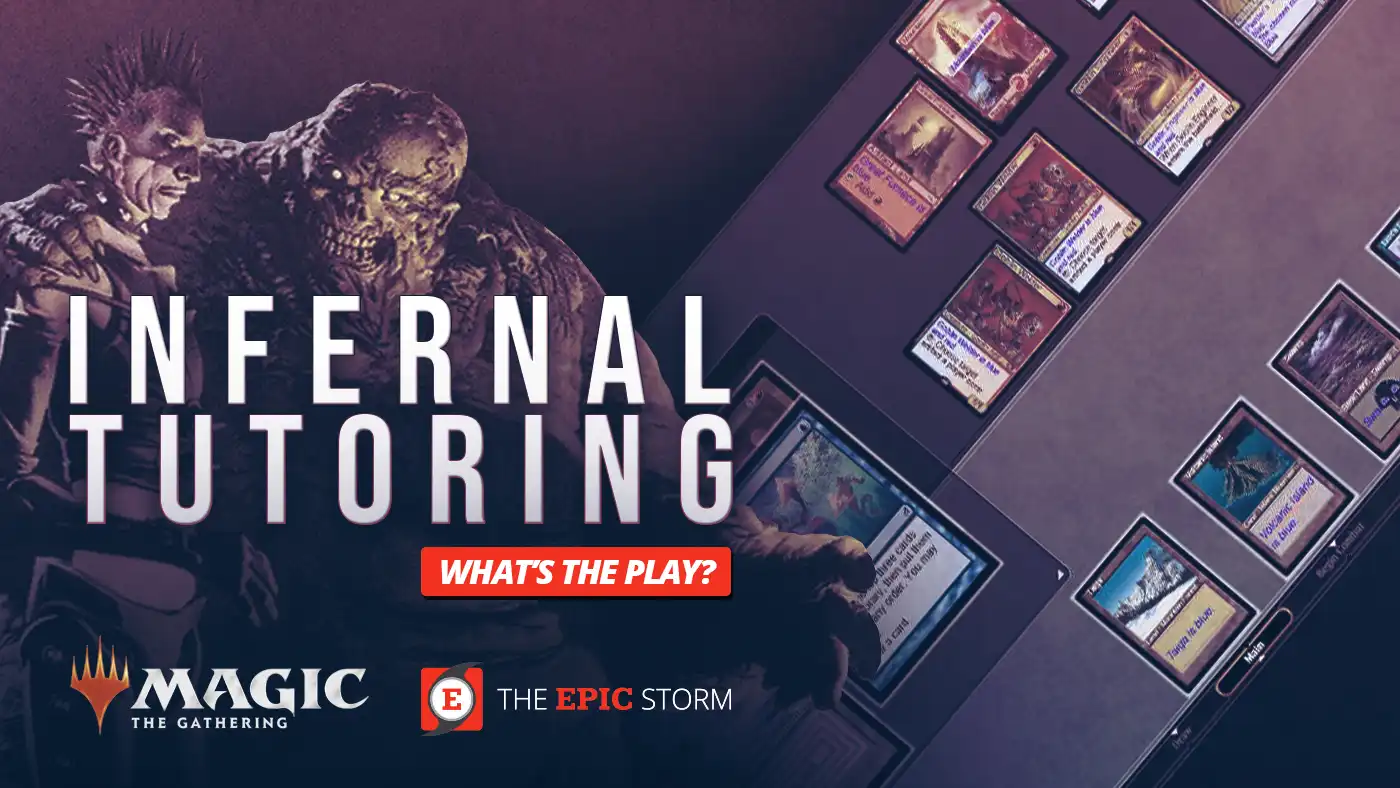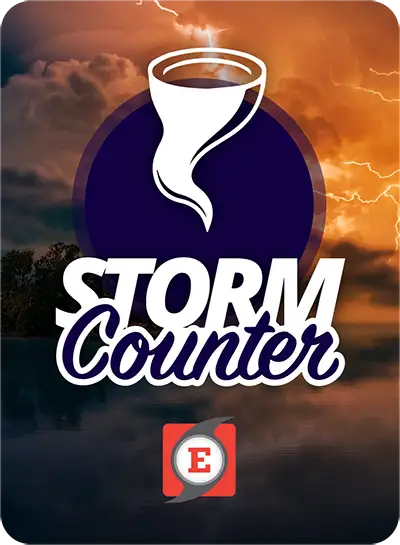Breaking News: Infernal Tutoring is actually playing [[Infernal Tutor]] again!
The EPIC Storm has recently undergone a large shift thanks to some dedicated testing focused on how to stay competitive in the current Legacy metagame. It all began with the adoption of [[Mishra's Bauble]] over [[Ponder]] — a change brought about by the recognition of synergies with [[Galvanic Relay]] and [[Mox Opal]]. It recently has culminated in the re-adoption of [[Infernal Tutor]] — a classic Storm tutor. The EPIC Storm hasn't played with this nerfed [[Demonic Tutor]] since the printing of [[Wishclaw Talisman]], and the reason it's back may not be immediately apparent.
The previous deck versions with [[Urza's Bauble]] made changes to optimize the playability of [[Galvanic Relay]]. This additional zero-drop artifact also focused on enabling Metalcraft for [[Mox Opal]], something [[Wishclaw Talisman]] was also good at doing. The scene where [[Wishclaw Talisman]] was eating otherwise useless copies of [[Prismatic Ending]] became increasingly common. The EPIC Storm used to play cards like [[Carpet of Flowers]] and [[Defense Grid]] that would tax an opponent's removal spells, but with an empasis on [[Galvanic Relay]] to bypass fair blue decks, these permanents have been dropped for the time being. This left [[Wishclaw Talisman]] as the target of all opposing removal spells. It may have been correct to evaluate [[Wishclaw Talisman]] in the [[Galvanic Relay]] light much earlier than now, but it was difficult to see a reason to remove a card that checked so many boxes.
When [[Infernal Tutor]] was finally reconsidered, the card more than impressed. With this new tool, main-deck [[Galvanic Relay]] lines have been cleaned up. Five mana instead of six can make a huge difference (it's as simple as [[Dark Ritual]] + [[Rite of Flame]]), and it doesn't come with the downside of needing to hand our opponent a copy of whatever card they want in post-board games. The heuristics of playing with a card that requires a player to be Hellbent will be necessary to pick up, but it can be similar to playing out of the sideboard with [[Burning Wish]] and [[Lion's Eye Diamond]]. There are certainly more interesting lines available to us now, but discussing them here may spoil some of the puzzles ahead! At the very least, there needs to be a discussion about the removal of [[Echo of Eons]] from the main deck. Because of the requirements for Hellbent, [[Lion's Eye Diamond]] is typically sacrificed to empty our hand when [[Infernal Tutor]] is on the stack. This presents a problem because that discard outlet is necessary for the Flashback on [[Echo of Eons]]. Because of this, the card has to be relegated to the sideboard.
The EPIC Storm v14.6 is faster, leaner, and more able to dodge incidental hate than its [[Wishclaw Talisman]] predecessors. Playing with this list can make you, dear reader, a better combo player. Let's dive into this month's puzzles and see what there is to learn about this major deck shift for Storm!

Special Guest
Martin Nielsen
(YouTube: Nevilshute | Twitter: @MartinFSNielsen)
I'm from Copenhagen, Denmark, where I live with my wife and two children (aged 5 and 7).
I've been playing Magic on and off since 1994 and have been playing Legacy at a competitive level since 2012.
I love casting Dark Ritual and initially played ANT for many years. I took some breaks, especially after becoming a father, and by the time I came back to Magic, it seemed the time had come and gone for ANT. Luckily for me, Thassa's Oracle was printed, and I picked up Doomsday. I had played the old DDFT (Doomsday Fetchland Tendrils) sporadically during my ANT days and, I had always held a fascination with the card Doomsday. Once it become a viable tier 1-2 strategy, I have not really looked back.
I run a YouTube channel where I release a video each week of me playing a Legacy deck (often Doomsday but not exclusively) on Magic Online where my name is Nevilshute.
For a living, I work at Denmark's national statistics agency producing, analyzing and disseminating statistics on the labor market and on living conditions.
Deck List
the epic Storm
Main Deck
- 4 [[Brainstorm]]
- 4 [[Veil of Summer]]
- 4 [[Mishra's Bauble]]
- 4 [[Urza's Bauble]]
- 4 [[Infernal Tutor]]
- 4 [[Burning Wish]]
- 3 [[Galvanic Relay]]
- 1 [[Ad Nauseam]]
- 4 [[Rite of Flame]]
- 4 [[Dark Ritual]]
- 4 [[Lion's Eye Diamond]]
- 4 [[Lotus Petal]]
- 4 [[Mox Opal]]
- 4 [[Bloodstained Mire]]
- 1 [[Scalding Tarn]]
- 1 [[Misty Rainforest]]
- 1 [[Verdant Catacombs]]
- 1 [[Underground Sea]]
- 1 [[Volcanic Island]]
- 1 [[Bayou]]
- 1 [[Badlands]]
- 1 [[Taiga]]
Sideboard
- 2 [[Xantid Swarm]]
- 3 [[Abrupt Decay]]
- 2 [[Crash]]
- 1 [[Thoughtseize]]
- 1 [[Grapeshot]]
- 1 [[Galvanic Relay]]
- 1 [[Empty the Warrens]]
- 1 [[Tendrils of Agony]]
- 1 [[Pulverize]]
- 1 [[Echo of Eons]]
- 1 [[Peer into the Abyss]]
SITUATION No. 1 — Rakdos Reanimator
Reanimator strategies have seen a resurgence in recent months in Legacy. The power behind a turn-one [[Griselbrand]] remains relevant. With the inclusion of even more protection in the form of [[Grief]], the disruptiveness found in this Rakdos build has reached critical levels. [[Thoughtseize]], [[Unmask]], and now [[Grief]] lay the foundation for a package that nearly guarantees the ability to [[Reanimate]] a giant monster as soon as a player wants. [[Griselbrand]] is far and away the best choice for Reanimator, but several alternatives have cropped up that have unique abilities more suited for specific situations. [[Archon of Cruelty]] can remove problematic creatures, draw cards, and disrupt an opponent's hand with ease. [[Atraxa, Grand Unifier]] functions as bulk card draw independent of life total — a feat even [[Griselbrand]] cannot yet achieve. In addition to playing with new toys, Reanimator decks have been working around their greatest weakness when it comes to sideboard plans.
When a strategy necessarily uses the graveyard to function and attacking with a single creature to win, there is an abundance of hate cards to employ. [[Leyline of the Void]], [[Endurance]], [[Surgical Extraction]], [[Swords to Plowshares]], [[Solitude]], and many others can all spell certain doom for an aspiring Reanimator player. Instead of trying to address everything in their sideboard plans, players have been doing two things:
- Relying on discard to punch through. This works with virtually every card mentioned above with the exception of [[Leyline of the Void]]. With builds of the main deck containing upwards of 10 discard spells, the way can be made clear by relentlessly assaulting an opponent's hand until they have no interaction remaining. Especially since cards like [[Grief]] and [[Unmask]] have no mana requirements, the land-light Reanimator plan can function underneath the discard. Just like Modern Rakdos Scam, casting [[Reanimate]] on [[Grief]] can put an opponent off balance enough in the early turns to translate into a win in the midgame.
- Playing with a sideboard juke. Not all shifts in strategy need to include swapping 15 cards in the board for 15 cards in the main. Reanimator has balanced on a delicate line that respects the power of their deck, but also allows for the inclusion of cards that function outside of their main plan. [[Dauthi Voidwalker]] directly comes to mind here, as does [[Show and Tell]]. Both of these cards seek to circumvent common answers: either by being lower to the ground or by avoiding the graveyard.
With these updates to an already-powerful strategy, Reanimator has been catapulted into a solid A-tier deck. Alongside this, the Legacy format has gone away from decks that have typically punished Reanimator. [[Swords to Plowshares]] is seeing less play as both Death & Taxes and Control have suffered in this combo-heavy metagame. Reanimator has appreciated this change though, as heavy discard can not only protect one's own combo but disrupt that of an opponent's as well! This just goes to show how effective reevaluation of the norm alongside positive metagame construction can push a deck over the edge.
For our first situation, we are facing down a stacked graveyard from our opponent — threatening a powerful [[Griselbrand]] or [[Archon of Cruelty]] as early as the next turn! Our draw for our first turn was [[Bloodstained Mire]]. Since it is game one, we have an opponent who is not expecting The EPIC Storm. A few lines available to us, and deciding between them is not clear-cut. What can we do on our turn to best secure a win?
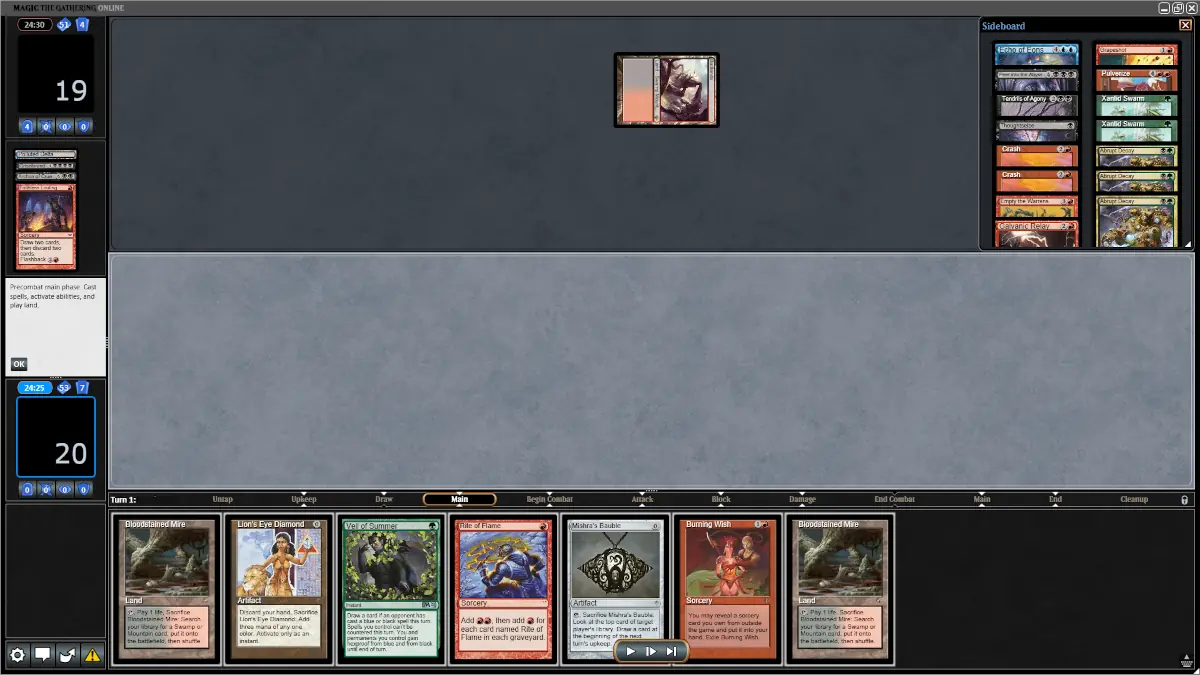
SITUATION No. 2 — Death & Taxes
As previously mentioned in the Reanimator introduction, Death & Taxes has seen a drop in success recently. The deck was situated quite well after the most recent Banned & Restricted announcement, but numbers have dropped off since then for the mono-white Midrange deck. Regardless of the current standings in Legacy, Death & Taxes is a deck that functions quite well in the hands of a competent pilot. The balancing act that is needed to determine the correct lines of play (all without the Cantrip Cartel) truly distinguishes good pilots from great ones. [[AEther Vial]], [[Stoneforge Mystic]], [[Flickerwisp]], [[Recruiter of the Guard]], [[Wasteland]], and [[Rishadan Port]] all serve to complicate a pilot's decision tree. Add 20 extra cards and a [[Yorion, Sky Nomad]] Companion and you are in deep.
The EPIC Storm can have a positive win rate against Death & Taxes, but there is play in the matchup. [[Thalia, Guardian of Thraben]] is a main-deck piece of disruption that is difficult to play through. Luckily, [[Grapeshot]] can allow a game one win through the problematic hate bear, though it can be quite mana-intensive to do so. In post-board games, [[Deafening Silence]] and [[Ethersworn Canonist]] are the two most concerning cards. These often see an opponent aggressively mulligan to find them in an opening hand. Our sideboard is prepared with [[Abrupt Decay]] ready to go. One remaining piece of interaction that can be brought to bear is [[Mindbreak Trap]]. With a [[Thoughtseize]] in the board as a [[Burning Wish]] target, this can be dealt with if there is enough mana available. Another tool in our quiver is [[Xantid Swarm]]. Able to turn off all interaction for the turn, [[Mindbreak Trap]], [[Surgical Extraction]], and [[Solitude]] on [[Germ Token]] are all shut-off. The peace of mind that comes with [[Xantid Swarm]] is not just for blue decks.
As classic as peanut butter and jelly, Infernal Tutoring articles and resolving [[Brainstorm]] go hand in hand. This [[Brainstorm]] asks a unique question about our deck. It is our opponent's end step in game one on the draw, and we know two cards in our opponent's hand ([[Flickerwisp]] and [[Recruiter of the Guard]]). Instead of deploying a two-mana hatebear like [[Thalia, Guardian of Thraben]] on their turn, our opponent opted to cast [[Umezawa's Jitte]]. A card that does not often have relevant text against our creatureless combo deck. What does this tell us about their hand? Do we have time to continue sculpting or should we prepare for a quicker clock?
Author's Note: The maindeck of the list played here is exactly the same as TES v14.6. As you can see in the popped out sideboard, however, there are three copies of [[Thoughtseize]] instead of one copy along with two copies of [[Crash]]. This is an earlier build of the deck that followed the adoption of [[Infernal Tutor]] and plays very similarly.
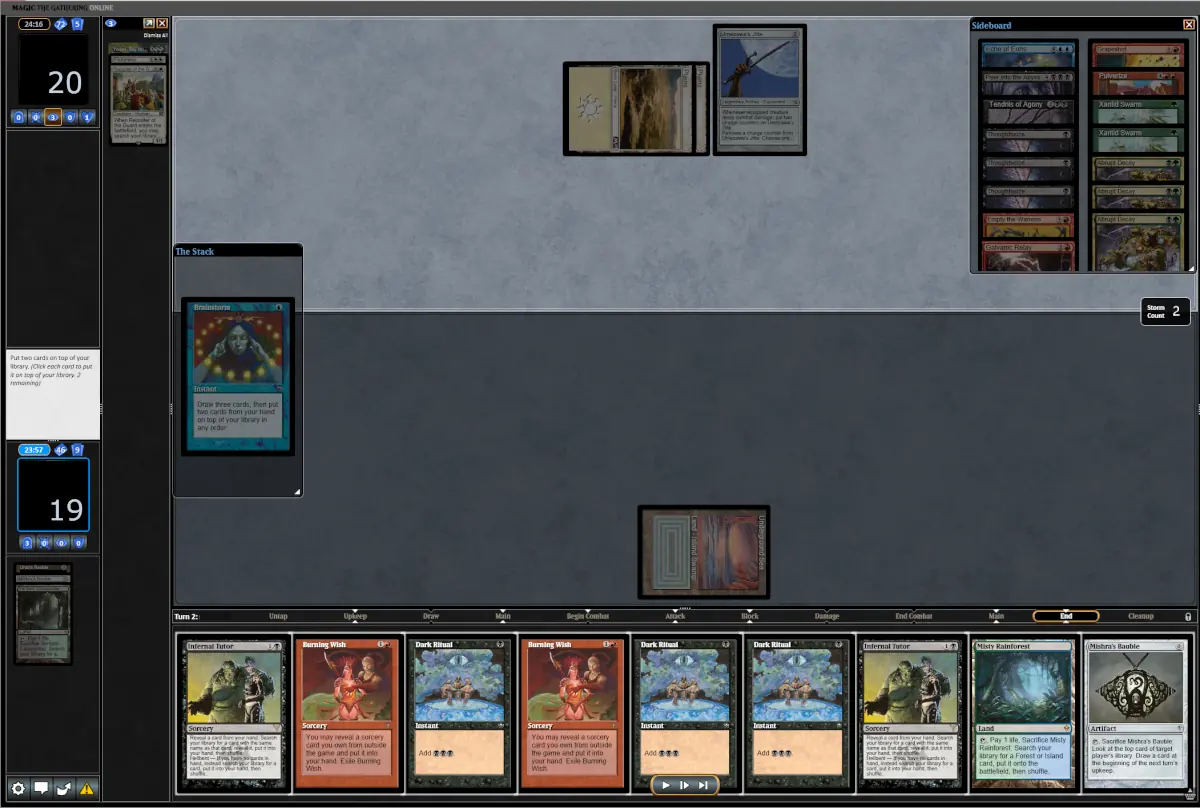
SITUATION No. 3 — Temur Rhinos
When Modern's technology enters the Legacy format, it typically fairs poorly. [[Omnath, Locus of Creation]] is not a viable four-mana creature for example. When you pair the strengths of both formats, something is created that feels like a Vintage deck!
Temur Rhinos is a Cascade deck that seeks to put [[Crashing Footfalls]] on the stack as quickly as possible — it does so in Modern and Legacy in the same way. The Cascade spells [[Shardless Agent]] and [[Violent Outburst]] allow the sidestep of timing restrictions with Suspend cards but come at a deck-building cost of not being allowed to play any one or two-mana spells. With an inability to play traditionally used mana acceleration, [[Elvish Spirit Guide]] and [[Simian Spirit Guide]] are cards that will be passed by a Cascade trigger but quicken a player's ability to put eight power into play. This mana acceleration, paired with an abundance of free spells, sets Legacy Rhinos apart from its younger kin. [[Force of Will]] is easily the poster child of this disparity, providing Rhinos a protective and disruptive element to its strategy. This deck is quite reminiscent of certain [[Bazaar of Baghdad]] decks in Vintage that operate on a similar axis ‐ quick and efficient clocks backed up by egregious amounts of free spells. This may easily be confused as a combo deck, and it's easy to see why. Abuse of mana costs is shared between Rhinos and other combo decks like Oops! All Spells. When Rhinos "does its thing" the result is two creatures on the battlefield, not a game win. Because of this, Rhinos can more aptly be considered a Tempo deck that plays more similarly to UR Delver than The EPICS Storm.
Speaking of The EPIC Storm, our own matchup against Temur Rhinos can be quite difficult. Their clock is quick and efficient enough to end games once deployed. But the real concern is their overabundance of countermagic. It is very likely that playsets of both [[Force of Will]] and [[Force of Negation]] are available in post-board games. Other cards with potential are [[Mystical Dispute]], [[Force of Vigor]], and [[Boseiju, Who Endures]]. With that being said, The EPIC Storm is quite proficient at beating single-point interaction. [[Veil of Summer]] and [[Galvanic Relay]] both pose difficult questions for opponents to answer. Likewise, [[Xantid Swarm]] does the same in post-board games. [[Endurance]] and [[Brazen Borrower]] are causes for concern for our tiny insect friend, as is [[Fire // Ice]]. But with careful deployment, we can swarm our opponent easily!
SIDEBOARDING:
+2 [[Xantid Swarm]]; -1 [[Galvanic Relay]], -1 [[Urza's Bauble]]
What a board state! Our opponent has cracked open two cans of rhinos, courtesy of [[Violent Outburst]] and [[Crashing Footfalls]]. Because of the nature of Cascade spells, our opponent revealed 46 cards to us! Among them are seven pieces of free countermagic and a playset of [[Force of Vigor]]. This prompted an [[Urza's Bauble]] activation to determine the identity of one of the two cards remaining in our opponent's hand. It revealed the last copy of [[Force of Negation]]. They may also have the Blue card to go with it! This [[Galvanic Relay]] turn already started with the deployment of several zero-mana artifacts. With two cards in Exile and a [[Burning Wish]] in hand, there are a handful of options available to us, but we are on a limited timetable. Lethal damage is staring us down across the table, so this turn needs to result in a win for the home team. How many of these options allow us to play around the known piece of countermagic in our opponent's hand? Should we respect that they would keep a Blue card in their hand as well? What should we do on our turn to maximize our success?
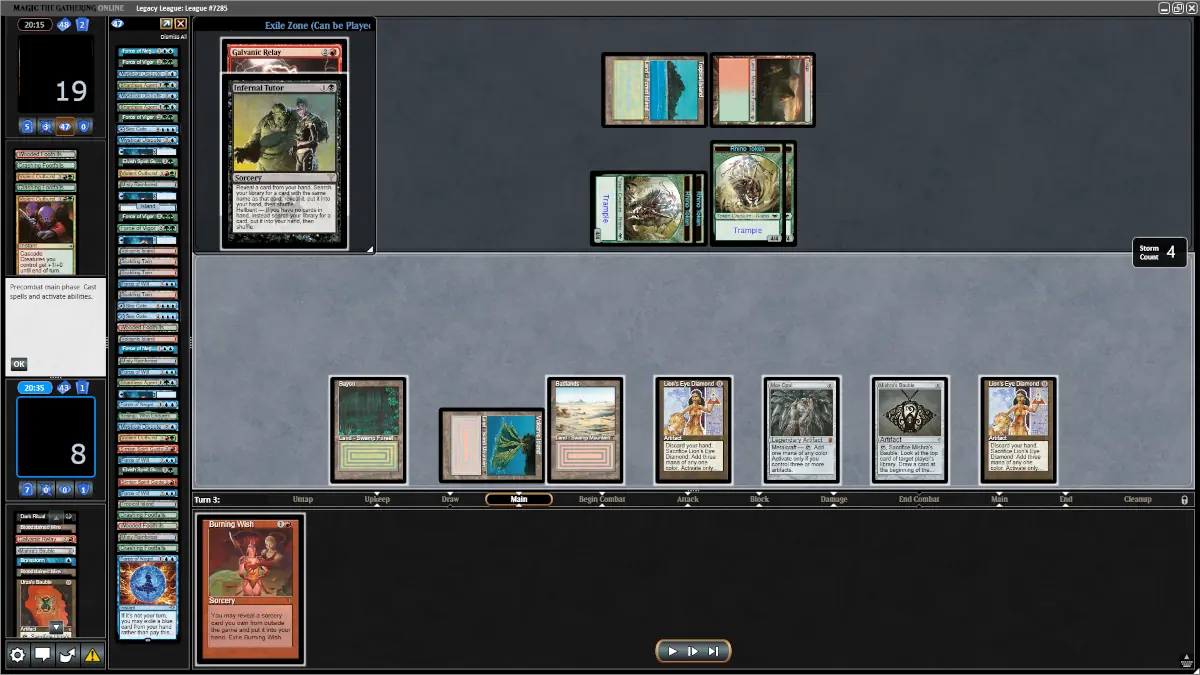
Want to see your play?
We're now allowing for fan-based submissions for "Infernal Tutoring!" In order to submit, scroll down to the footer to the contact form. Attach your screenshot, describe the situation in detail, and press submit!
Disclaimer: Regarding the details of the scenarios, we do not want what the outcome of the situation is. For example, if the question is, "Do I go for it here?" do not tell the team if your opponent had [[Force of Will]] or not. This information honestly doesn't matter for our purposes and it doesn't change the answer if it's correct or not to cast the business spell. Thank you for your understanding.
Instructions
- Use the subject line of "Infernal Tutoring"
- Write what list you are playing and if there's anything special about your list compared to the current stock version. Scenarios that contain the current list are more likely to be selected.
- If possible, please resize your images to be no larger than 1400px wide and preferably under 125kb. This will make our job easier, if you're unfamiliar how to do this that's okay too. Still message us with your scenarios!
